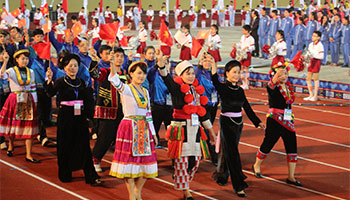Vietnam is a multi-ethnic country with 54 ethnic groups, in which the most crowded group is the Viet (Kinh) accounting for 87% of the country’s population. They live in the major cities, in the Red River delta, the central coastal delta, and the Mekong delta. The other largest ethnic groups are Tay (1.9%), Tai (1.7%), Muong (1.5%), Kh’mer Krom (1.4%), Hoa (1.1%), Nung (1.1%), H’mong (1%) and other groups (4.1%). They settle over mountainous areas lasting from the North to the South of the country
Origin of Vietnamese People
According to some unverified theories, the formation of the origin of Vietnamese people is divided into three periods below:
- In the Epi-palaeolithic period, the Vietnam nationality was considered to be a blend of the Mongoloid who lived in Indian subcontinent migrating to the East and stopped in the present Indochina area – a part of the local Australoid who had been living here before, as a result, the birth of result is the birth of the Indonesien or Proto-Malay was given.
- At the end of the Neolithic, at the area now known as the South of Vietnam, the Proto-Malay and the Mongoloid moving from the North created a new race named the Austro-Asiatique.
- After that, the Austro-Asiatique separated itself into other nationalities from time to time, which was known as the name of Bach Viet in the Vietnamese and Chinese old books. This process of separation still continued until the Vietnam ethnic groups and their languages were formed as seen in the present.
These theories are not unproven for their accuracy or fallen in some illogical things which scientists, anthropologists, and archaeologists effort to discover the true origin of Vietnamese people.
The Vietnamese legend says that the ancestor of Vietnamese people is rooted in the legend of “Children of Dragon, Grandchildren of Gods”. Lac Long Quan – a king of the dragon gets married to a goddess, Au Co who was the daughter of the bird king De Lai. Au Co laid a sac of one hundred eggs hatched into one hundred children. After that, the spouse was separated into two parts of 50 children per side. Au Co led their fifty children to the upland to live, exploit, and establish a new nation. These people are considered the ancestors of the Vietnamese. Patterns of the deer symbolizing mountains and water birds symbolizing plains found on in the Bronze Drum make a lot of people believe in the legend. The present Vietnamese generations are proud that they are Children of Dragon, Grandchildren of Gods.
The Diversity of Vietnamese People
Each Vietnam Ethnic Group shares identifiable differences in their own culture, lifestyle, and language yet they still have several common factors in their life. Vietnam ethnic groups can be divided into 8 different groups as follow:
- The Viet - Muong Group includes 4 ethnic groups: Chut, Kinh, Muong, Tho.
- The Tay - Thai Group includes 8 ethnic groups: Bo Y, Giay, Lao, Lu, Nung, San Chay, Tay, Thai.
- The Mon - Khmer Group includes 21 ethnic groups: Ba Na, Brau, Bru-Van Kieu, Cho Ro, Co, Co Ho, Co Tu, Gie Trieng, Hre, Khang, Khmer, Kho Mu, Ma, Mang, M'nong, O Du, Ro Mam, Ta Oi, Xinh Mun, Xo Dang, Xtieng.
- The Mong - Dao Group includes 3 groups: Dao, Mong, Pa Then.
- The Kadai Group includes 4 ethnic groups: Co Lao, La Chi, La Ha, Pu Peo.
- The Nam Dao Group includes 5 ethnic groups: Cham, Chu Ru, Ede, Gia Rai, Raglai.
- The Han Group includes 3 ethnic groups: Hoa, Ngai, San Diu.
- The Tang Group includes 6 ethnic groups: Cong, Ha Nhi, La Hu, Lo Lo, Phu La, Si La.
The first main job of the Vietnam ethnic group was farming. They grew rice plants or others such as cassava, maize, and sweet potato in paddy fields or upland fields. From time to time, they enhanced from rudimentary agricultural tools to use farming techniques, which improved from their living standard to the development of Vietnam society. Though, there is a big gap in development among the ethnic groups, especially the minority ethnic groups. Most people living in mountainous areas are minority ethnic groups. They are slow on education, physical facilities, and healthcare equipment. Small children have to work soon or give births at a very young age.
The Vietnamese government has issued specific policies to support minority groups the best life. The solidarity lasting during the war of the resistance for defending the country now still remains to connect the lowland people and highland people, the delta and the mountain areas, the Viet and all other minority ethnic groups in Vietnam. For those keen on exploring the diverse cultural landscape of Vietnam and gaining insights into the lives of various ethnic communities, some of the best Vietnam tour companies can facilitate immersive experiences.



